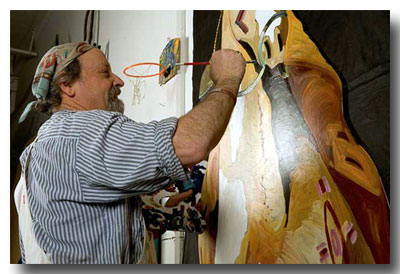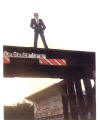| Friends Of The Little Bighorn Battlefield |
The Next Generation In The Study Of Custer's Last Stand |
Thom Ross |
| • The Battle • Archeology • Memorials • Little Bighorn Store • News • Book Reviews |
|
Photo courtesy of Thom Ross & Patrick BennettWebmaster's Note: Once one has viewed the art of Thom Ross, one never forgets it. You've seen his art on many bookcovers including the just published, "Wild Women of the Old West" by Glenda Riley, and the recent addition of Robert Utley's, "Custer: Cavalier in Buckskin." Mr. Ross has written and illustrated his own book, "Gunfight at the O.K. Corral" with an introduction by Paul Hutton. Now the artist is in the process of completing a most ambitious art project like no other. So, I'll have Mr. Ross explain that to you along with some great photos. This project had its genesis many years ago. I was visiting a friend and on his wall was one of the famous Anheuser-Busch lithographs of “Custer’s Last Fight.” This lithograph was composed by F. Otto Becker and was distributed to numerous Anheuser outlets; thus, many people were first introduced to the story of "Custer's Last Stand" by viewing this image while downing a beer. While I gazed at the print on the wall, it occurred to me that the Battle of the Little Bighorn might be a wonderful subject to recreate in plywood. I wanted to do something more than just paint another painting of "Custer's Last Stand." I wanted to do something bigger and bolder than any other artist had yet attempted. I had done numerous plywood cutout art pieces. The first one was of the Clint Eastwood cinematic character, "Dirty Harry." In the final scene of the movie, Harry leaps from a train trestle onto the roof of a bus in which the killer is traveling. This train trestle was located just a few miles from where I was living at the time in San Rafael, California. With my good friend, Mike Shea, we cut out the shape of "Dirty Harry" and painted him up, complete with the dark sunglasses and Eastwood's trademark "pompadour" hairstyle. Early one morning we drove down to the train trestle and nailed the plywood figure on the same spot where Eastwood jumped from in the movie. My Plywood cutout of "Dirty Harry" -- February1976In 1977 I moved to Jackson, Wyoming, and in my eight years of living there I produced some fun, and controversial, cutout art pieces. The most popular one was “154 Nevermore". This piece consisted of 154 plywood raven cutouts, which were nailed to fence posts along Highway 22, which runs from Teton Pass to the town of Jackson. The 154 ravens were divided in two groups and set up so that they faced each other, 77 on one side of the road, 77 on the other.
Here I am posing with 154 raven cutouts -- Jackson, WY April 1983
My next piece was "Willie Mays: The Catch" which was a five paneled piece showing Mays making his famous catch off the bat of Vie Wertz in the first game of the 1954 World Series. The catch was only possible due to the fact that the game was played in the old Polo Grounds in Manhattan. The centerfield fence was about 485 feet from home plate; hence, Wertz's drive would have been an easy home run in any other park. But due to the depth of the centerfield fence, Mays was able to race back to the fence and make his now famous catch. This piece first appeared outside of Petaluma, California, on May 6, 1984, to commemorate Willie’s 53rd birthday.
"Willie Mays: The Catch" as it first appeared on a hillside just south of Petaluma, CA -- May 6, 1984
I then returned to Wyoming and placed the "Mays" piece on a hillside above Spring Creek Gulch.
"Willie Mays: The Catch" Spring Creek Ranch, Jackson, WY -- June 1986
In 1996, while living in Seattle, I entered a competition to choose artwork for the Seattle Mariners' new baseball stadium, SAFECO Field. The competition was open to artists living in Oregon, Washington, and British Columbia. Over 100 proposals were submitted. Of these, they made a "short list" of 1 8 artists and I was one of them. Each artist was then required to meet the judges of the art committee and discuss their own life, their art, and baseball. Well, this was no problem for a motor mouth like me, especially when discussing something I love as much as baseball. By the time I got home from this presentation the phone was already ringing. It was my representative and she was still laughing as she told me that the board was very impressed with my enthusiasm for, and my love of, baseball, and that they were going to offer me the opportunity to create my piece. The subject of my proposal was an 11 steel cut-outs showing the Seattle Mariners' most cherished moment; Ken Griffey Jr. sliding across the plate to complete a come-from-behind victory which eliminated the New York Yankees from playoff contention in October, 1995. In this play-off series, one team had to win 3 games to advance to the American League Championship Playoffs. The Yankees won the first two games in New York, and then the series moved to Seattle. (It should be noted that, up to this time, Seattle was a "football" town and that the lowly Mariners had never done much of anything.) Well, the Mariners won the next two games to force the fifth, and deciding, game. Down by one run, the Mariners got two men on base, Joey Cora stood at third, while Ken Griffey Jr. stood at first. The next hitter was the great Edgar Martinez. He lined a double into left field; Cora scoring easily. But then here came Junior, chugging and running and huffing and puffing for all he was worth. He beat the throw by 10 feet and the Mariners had staged one of the greatest comeback victories in playoff history. Sadly, they were eliminated by the Cleveland Indians in the Championship Playoffs, four games to two, but that one moment when Junior slid across the plate made baseball a real passion in Seattle. I felt that by choosing to recreate this moment, anyone who viewed the piece would recall that great and exciting moment in their own life and THAT was where the “art" was to take place, in the heart and the soul of the viewer. The piece was installed in the spring of 1999.
In the summer of 2000 I returned to Jackson, Wyoming, and installed a second version of the “154 Nevermore" raven piece. The birds were installed on the same fence posts I had used for the original installation 18 years before. This time the ravens were fabricated out of steel and were auctioned off at a local art gallery to raise money for the Jackson Hole Art Association.
The following photographs show the "works in progress" for my newest project, a plywood cutout version of "Custer's Last Stand." The plywood figures will be life-size, cutout of a standard piece of 8' X 4' plywood. The mounted warriors and the wounded cavalry horses will be cutout of larger pieces of marine plywood so that they, too, will be life-size. It is my hope to have about 120 - 200 figures completed and set for installation near the battlefield by May 2005. The piece will be installed near the battlefield in time for the 129th anniversary of the famous fight, June 25, 2005. After a three-day stint there, I will transport it to the Buffalo Bill Historical Center in Cody, Wyoming, for another three-day stint. Then I will take it to Jackson, Wyoming, and, finally, to Sun Valley, Idaho. A whole new generation is learning about Custer’s Last Stand for the first time, again. My daughter, Olivia, who is only 14, has learned to appreciate the importance of history through the Little Bighorn story and in helping me make these figures. I might add, too, that many of the members of the Friends of the Little Bighorn Battlefield are of the younger generation. The children of our future learn to love history in ways that intrigue them. These unique, colorful, and bold figures help carry the Little Bighorn Battlefield into the 21st century. The success of these figures will also contribute to the ongoing success of the Friends of the Little Bighorn Battlefield through personal contributions on my part. We’ll keep posting photos on the Friends’ website following the completion of ongoing figures. We hope you’ll return often to see what new soldiers or warriors come to life. Warmest Regards, Thom Ross
Battle Art Home |
|
|||||||||||||||||||||
|
Copyright 1999-2013 Bob Reece Friends Little Bighorn Battlefield, P.O. Box 636, Crow Agency, MT 59022 | Home |
Board of Directors |
Guest Book | Contact | Site Map
| |
||||||||||||||||||||||












